Knowing where your website ranks on Google is an important part of any modern online marketing strategy.
In 2022 and beyond, search engine result pages (aka SERPs) are a complicated place and often feature ads, local listings, traditional organic traditional listings and many other types of results that vary based on the search query. This complexity is further compounded by the fact that search results often differ for each user depending on many signals such as location and search history.
The offshoot of this is that what you see is not necessarily what the next person conducting the same search will see. The location of the person conducting the search is one such variable that is used to create truly dynamic and personal results for each user.
This all adds up to make checking your rankings somewhat more complicated than it once was in the days when Google returned a relatively static set of results (often known as ten blue links).
Despite this complexity, it is still important to check your rankings. You can’t have SEO goals if you don’t know your current situation and your current rankings inform your SEO strategy.
In this article, we will show you the many ways to see where you rank on Google. We will show you how to do this manually, typically for free, and we also review the tools that can help you keep regular track of where you rank.
Contents and quick links
For those of you short on time you can jump straight into the part of the article most relevant using the link below:
- Understanding Search Results – Paid, Local, Organic & Everything Else
- Checking Where Your Website Is Ranking with Search Console
- Checking Local Rankings with Bright Local
- Using a Private Browser Session to Check Your Rankings
- SEO Software and Rank Tracking Tools
- Ranking Fluctuations – how rankings change
If you have any questions or just feel flummoxed and don’t know where to start just drop me a line – I am more than happy to have a look at your rankings and give you some input. Alternatively, we have a free SEO audit and battle plan that will tell you exactly where you are and what you need to do to improve your rankings and start generating more work from Google: Free SEO Audit & Plan.
i. Do you need rank tracking software?
There are many tools out there that will happily take your money to give you ranking information. However, interpreting this data can be difficult and for small businesses, you can often find all you need without an expensive subscription. Google Search Console (1) is a treasure trove of ranking information – if you know how to interpret the data and it is free. But, even if you do decide to go with some rank tracking software we will help you understand what tool is right for your business and the type of rankings you are tracking.
Whatever you decide, if you can take 15 minutes to read this article you will be better informed and ready to use the ranking information to help grow your business.
1. Understanding Search Results – Paid, Local, Organic & Everything Else
The first step to understanding where your site ranks on Google is to understand the layout of a search results page.
Search Engine Result Page Layout
There are typically three sets of results for any given search:
- paid results
- local results from Google maps
- organic results
- page features
The paid results are generally at the top of the page and can include various types of ads (text ads, products etc). The local listings tend to sit under the paid. Then we have the main organic results. The organic results tend to have any number of page elements all blended together to provide the best possible selection of results for the user’s search query.
The organic results have many features including:
- product listings (with images)
- featured answers
- detailed information on a given “thing” like a business (knowledgepanel)
- images
- news
- social media content
- FAQs
- Related Searches
- Hotels
- Flights
- Jobs
That is not an exhaustive list but I am sure you get the point – the results will be customised based on the type of search query and the user’s search history.
Paid Search – The true top of Google
If your goal is to get to the top of Google for the kind of queries that drive business enquiries then you almost certainly need to look at Google Ads PPC.
You can set this up yourself and utilise Smart Campaigns which are a simplified (but flawed) way to advertise on Google. Or, you can employ the help of a Google Ads PPC Agency. There is a lot of information out there to help you but be prewarned that PPC can be a competitive environment for new advertisers.
Knowing where you appear in Google Ads is relatively simple and the platform provides simple metrics so you can see when you appeared in the top pack or the very top of the results.
Local Search – top of the free (organic) listings for most local business queries
The local results are heavily influenced by location but also can be optimised by Local SEO. If you are a local business then you will want to rank check where you appear in these results and consider various searcher locations to see the variance by distance. As an example, our Bowler Hat site ranks in local results when I search from within Birmingham where we are based. But, if I search for an SEO company when I am at my home, we are pushed just out of the top 3 and I see other companies that are closer to where I live.
Search for “SEO company” within Birmingham (where we operate):
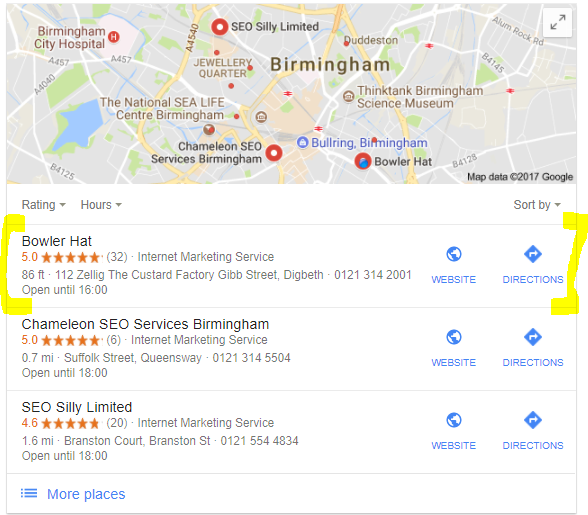
The same search for “SEO company” from where I live several miles away:
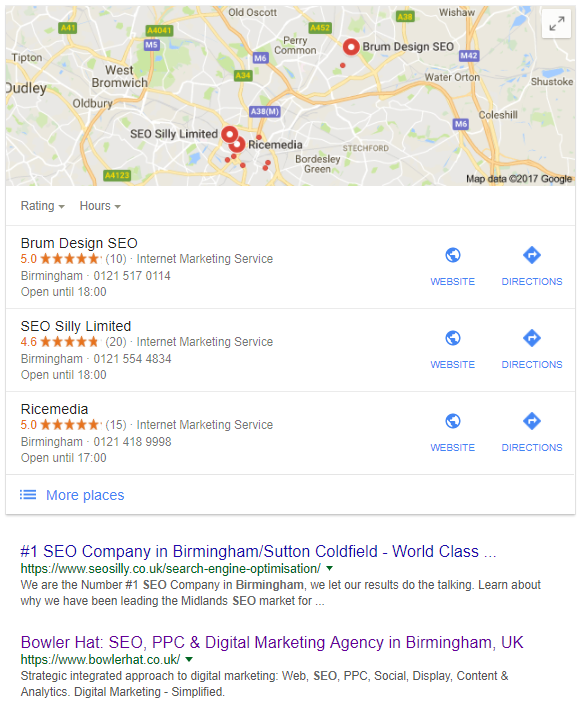
In this search – despite all other variables being the same – when the searcher location changes, the results can change to reflect the local intent behind the search query. Birmingham is a big place after all and Google believes that when people search for an “SEO company” they are looking for someone local to them.
The takeaway here is that getting a big picture overview of where you rank in the local results requires checking from various locations and there are tools that will check your rankings in a grid across a geographic area.
Organic – 10 blue links
Depending on the type of search query the organic results can be directly below the Google Ads or below the local listings if present. The local listings will generally be present if the query has local intent, that is the user is looking for a local business. Searches like “plumber”, “builder” etc all tend to have local intent and it would be of no use if the results returned were 100s of miles from your location.
Just to further complicate things the local pack can appear anywhere on the page. Typically, it is at the top, but if the confidence in the local intent behind this query drops then the local pack can drop down the page and feature within the other blended results.
If you are a local business, where you list in the organic results can also be affected by localisation and personalisation. This may mean that you can have two listings with one in the local pack and another in the organic results. You can also have a third listing if you run a PPC advert and have super on point SEO (PPC Listing, Local Listing, Organic Listing).
The following image shows Bowler Hat listed once at the top of the local results and then twice in the organic results for the search term ‘SEO Consultant Birmingham’. One of these organic results also has review stars.
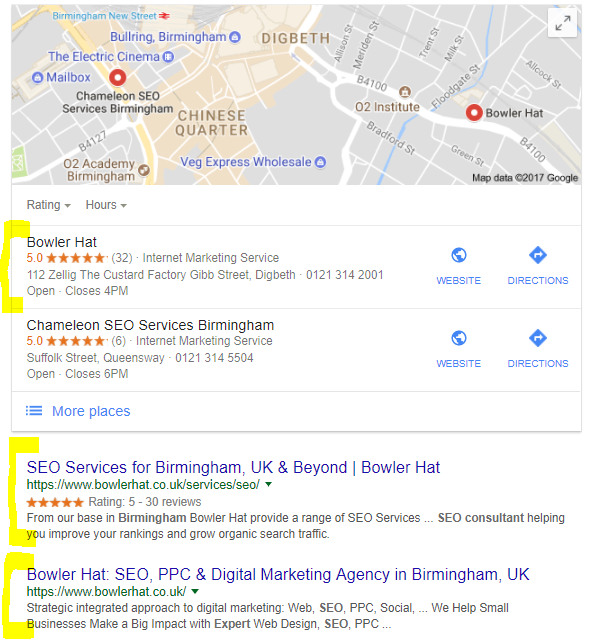
Hopefully, this gives you a better understanding of the different kinds of website ranking that is possible and what you need to consider when you are checking your rankings.
Okay, SEO 101 completed, we can now take a look at the methods to see where you rank and how to keep track of your keyword ranking positions over time.
2. Checking Where Your Website is Ranking in Google with Search Console
Google search console provides us with some average values showing where your website ranks for a variety of search terms. These figures are not exact, and due to various factors (personalisation and localisation), the average figure can be somewhat misleading for local businesses. However, this is diagnostic information directly from Google so should always be reviewed as your first port of call.
Firstly, you will need to register your site with Google Search Console.
Google Search Console rank tracker provides four key metrics:
- Position – your average position
- Impressions – total times your listing was displayed
- Clicks – total number of clicks
- CTR – percentage value for times a listing was clicked
How to check website ranking on Google:
- Sign in to Google Search Console
- Click on your website from the list
- Click on Performance from the left-hand menu
Here we see a list of the keywords that you rank for and that are generating clicks.
You can order this data by clicks or impressions. You can also add Average CTR (Click Through Rate) and Average Position.
Improving this data
You will want to do a couple of things here to improve the data that you can see and use this as a Google rank checker.
1. Click on Impressions, CTR (click-through rate) & Position
2. Add a filter to only view results from your country by clicking the + sign (UK in our case)

This will give you the most accurate data regarding the position you rank for within Google Search Console.
When is your ranking not your ranking?
There is a problem here for local businesses that Google Search Console shows data that is filtered by country rather than your current location. This means your average ranking is just that, an average, so how you rank to someone who lives 3 miles from your location will be very different to how you rank for someone who lives 300 miles away. This means that if you care mostly about your rank with users in your locality, this data is most often not going to be terribly useful.
3. Checking local rankings
For most local businesses you need to know what your rankings look like to potential customers within the geographical areas you target. There are various ways to approach this, from simply conducting a search to using various free and paid software tools which we will detail below.
What is a local keyword?
One thing to consider here is what a local keyword is in 2022 and beyond. Rollback several years and to find SEO companies in Birmingham you would search for “SEO Birmingham” or similar. In this search term, you specify what you want as “SEO” and where you want it as “Birmingham”. However, Google is now clever enough to know that if you search for a company that would typically be a local business, you don’t need to enter the location, they will just show you local results based on your current location.
The takeaway here is that you need to search for your keyword on its own in the location you target and your keyword with the location you target to get the best possible overview.
Searching your targeted keywords
If you are in the location you target, or near to that location, you can search your target search terms. This is not foolproof, but it will give you an idea. You can try this from various locations and use a browser with an incognito tab to give you a rough and ready idea of where you are currently ranking.
Search from a given location
Bright Local has a cool little tool that will let you conduct several free searches a day and set the location you want to search from known as the Local Search Results Checker.
You can enter your location and targeted keywords and you will get results unbiased by personalisation – it’s a great tool and one that can help you get a better idea of what your users see in any given location.
You can use this tool for free if you manually check and there are also paid tools that will do this on a schedule for you so you can keep a historical check on ranks. All of these tools have a cost, so if you are using an SEO agency (like Bowler Hat) then this is often included in any ongoing SEO service.
If you are serious about understanding your results from multiple locations and tracking results over time, a paid SEO rank checker will give you the best results with the least effort.
Search results over a larger area
You may also want to know how you rank over a larger geographical area and some newer ranking tools can provide this service with rankings taken at multiple points across a grid.
Bright Local has a paid feature here called Local Search Grid but there are others like Local Viking that have more data points.
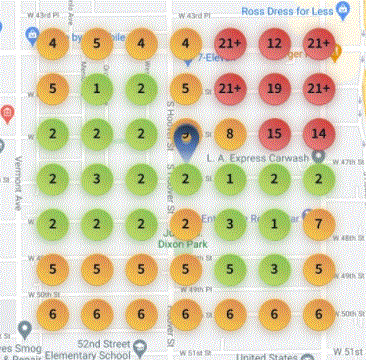
You can simulate this to some extent by searching from different locations using the free tools out there but if you want to really keep an eye on things then a local grid ranking tool like the above will give you the best information.
4. Using a Private Browser Session to Check Your Rankings
The major browsers all provide a private browsing session. On Chrome, this is called an incognito tab and on Firefox this is a private session. This can be useful to perform a manual check, but be sure to consider how your location when searching can artificially inflate your results here. If you sit in your office and search for the type of business you are then being so close can have a major impact.
You can disable the location element of the search which gives you an idea, but again this is also somewhat unrepresentative of the real world where the location will be a factor in the majority of searches. That said, if your keywords are not locally influenced then this will give you better results.
Caveats aside:
- Open up your favourite incognito browser (Chrome incognito tab works well)
- Search your keywords
- Cross-reference results
To be super diligent here try this from multiple locations – or ask your staff to try from their home address and take a screenshot.
5. SEO Software and Rank Tracking Tools
We have touched on this above but it is worth a recap as there are different tools out there and the right tool depends on your requirements.
Local Rank Tracking
If you are a local business and your keywords show a map pack in the results then you most likely want some local rank tracking software. We have no affiliation with any of these but the main players and our unbiased recommendations are for:
- Bright Local – best overall
- WhiteSpark – a close second
- Local Viking – best local grid tool
National Rank Tracking
If you are a national business or you target national rankings then you want a national rank tracking tool. Again, there are lots of options but our recommendations would generally be the big obvious tools:
- Moz.com – best overall
- Rank Ranger – comprehensive
- aHrefs – a great suite of tools
The reality is that there are many rank tracking tools and the best one will depend upon your needs and price sensitivity – it really is worth doing the research here.
Note: if you work with an SEO agency they will typically include this so don’t buy a tool if you are going to use an agency to do your SEO.
6. Ranking fluctuations
Now you know how to check your rankings it is worth quickly covering off how search results are becoming ever more real-time and variable. Keyword rankings can change day-to-day. In some cases hour-by-hour. Daily checking may drive you a little insane – we can call that rank fever! Determine how often you need to check and schedule your report or manual check (weekly or monthly is likely most sensible in most cases).
There are four main factors that will influence where your keywords rank at any time and for any given search engine user.
1. Algorithm Updates – Google is constantly tweaking and refining the algorithm that drives search results. Some of this tweaking is now likely driven by artificial intelligence (AI). Any change could impact your results in a positive or negative manner.
2. Localisation – What you see for any search query can be impacted by your location. If Google feels the query has a strong local intent, for example, if you are looking for a local service provider like a locksmith or plumber, then the location of you and the business will be a huge ranking factor. Typically, you will see businesses closer to you first.
3. Personalisation – Google also uses past browsing habits to show you more relevant results. If you have visited a site many times that site may show up more prominently. Users signed into Google (via Chrome, Gmail, YouTube etc) will be more likely to see personalised results. However, results will still be refined and personalised throughout a search session in a manner to help you get the best possible answer to your question.
4. User Engagement – Do people click on your search results? And when they click do they hang around and engage with your site? Where a page is returned in the search results and gets a low number of clicks or users quickly bounce back to the search engine, then this would indicate a poor result, and as such, rankings may suffer. Where a result gets many clicks and engages users then this result may see improvements. This is almost like a sanity check for the ranking algorithm so the algorithm places your listing but engagement determines if it sinks or swims.
Of course, the other factor here is any SEO work you are undertaking to improve the visibility of your site. Improvements to your site, content or high-quality backlinks should help improve your visibility. Too much optimisation or low-quality link building can negatively impact your visibility. In short – there are a lot of moving parts in determining where your site is shown to any given searcher for any given search query.
Summary
In the world of modern search engines that have so many possible inputs and variances in where your website may rank, even something as seemingly simple as rank tracking can be hugely complicated (*sigh*). There are some free ways to check your progress with some simple weekly checks, but you will save time using a professional tool, particularly if you are tracking lots of search terms.
Of course, most SEO packages and services will provide SEO rank tracking and analysis of other KPIs as part of the monthly work. And where understanding Google ranking variance across a range of locations is important, your Google rank checker will need to be configured with this in mind.
Remember, keywords and rankings are only valuable if they generate actual traffic and that traffic generates results. Typically, running a test of the keywords you want to target via Google Ads is a quick and easy way to determine what works and make sure you are not chasing keywords that will never do what you hope. Also, remember to dive into that Google Search Console traffic to ensure those rankings are actually driving clicks and engagement. Lots of moving parts!
Free SEO Audit & Battle Plan – if you find yourself a little lost with all the information you are not alone and we can certainly help. Get in touch today to get a free personalised SEO plan and consultation with me, Marcus Miller and put 20 years of SEO experience to work for your business: Free Personalised SEO Plan.
If you have any questions on the best way to track your rankings or would like to get your rankings professionally checked then get in touch or drop a comment below.
References and Further Reading


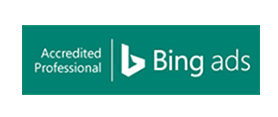




6 Responses
Thanks for the share Marcus, great article.
Do you use any other tools besides brightlocal?
Kind regards,
Filip
Hey Filip – too many to mention, unfortunately. Moz is one we have used for an age and Serpstat is a new one I am playing with. Serpstat is interesting as it shows SERPs with featured snippets etc. All more intel to build your attack. 🙂
Thanks for taking the time to reply Marcus, I really appreciate it.
Followed you on twitter by the way 🙂
Pleasure – take care – and I always follow back despite being a terrible intermittent Twitter user. 🙂
I couldn’t believe my eyes when I saw Google Search Console provided all that information – until I actually manually checked some of the terms they had listed for my site, that is. It’s crazily inaccurate, haha. I didn’t expect it to be super accurate, but what the heck – it has terms that it says I rank #2 or #1 for and I’m not even on the first 10 pages. Way to get my hopes up, Google!
Yep. There is some great info there. But it can also be a bit whacky. If you filter by the country you can often get it a lot closer to what actual prospective customers will see – but still, it can be a bit bananas. 🙂